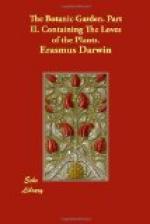The hyacinth-root differs from the tulip-root, as the stem of the last year’s flower is always found in the center of the root, and the new off-sets arise from the caudex below the bulb, but not beneath any of the concentric coats of the root, except the external one: hence Mr. Eaton, an ingenious florist of Derby, to whom I am indebted for most of the observations in this note, concludes, that the hyacinth-root does not perish annually after it has flowered like the tulip. Mr. Eaton gave me a tulip root which had been set too deep in the earth, and the caudex had elongated itself near an inch, and the new bulb was formed above the old one, and detached from it, instead of adhering to its side.
The caudex of the ranunculus, cultivated by the florists, lies above the claw-like root; in this the old root or claws die annually, like the tulip and orchis, and the new claws, which are seen above the old ones, draw down the caudex lower into the earth. The same is said to happen to Scabiosa, or Devil’s bit, and some other plants, as valerian and greater plantain; the new fibrous roots rising round the caudex above the old ones, the inferior end of the root becomes stumped, as if cut off, after the old fibres are decayed, and the caudex is drawn down into the earth by these new roots. See Arum and Tulipa.]
Soft
play Affection round her bosom’s throne,
And
guards his life, forgetful of her own.
So
wings the wounded Deer her headlong flight,
Pierced
by some ambush’d archer of the night,
265 Shoots to the woodlands with her bounding fawn,
And
drops of blood bedew the conscious lawn;
There
hid in shades she shuns the cheerful day,
Hangs
o’er her young, and weeps her life away.
So
stood Eliza on the wood-crown’d height,
270 O’er Minden’s plain, spectatress
of the sight,
Sought
with bold eye amid the bloody strife
Her
dearer self, the partner of her life;
From
hill to hill the rushing host pursued,
And
view’d his banner, or believed she view’d.
275 Pleased with the distant roar, with quicker tread
Fast
by his hand one lisping boy she led;
And
one fair girl amid the loud alarm
Slept
on her kerchief, cradled by her arm;
While
round her brows bright beams of Honour dart,
280 And Love’s warm eddies circle round her
heart




